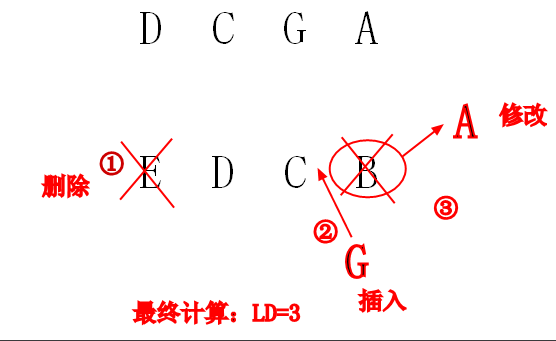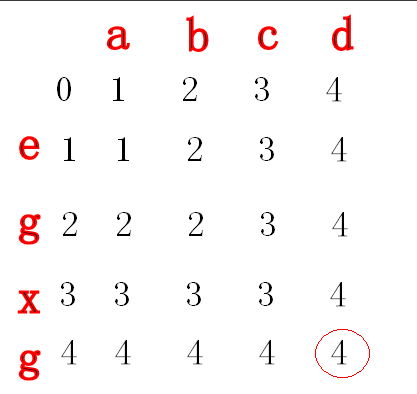一、概念
对于两个字符串 A 和 B,通过基本的增删改将字符串 A 改成 B,或者将 B 改成 A,在改变的过程中我们使用的最少步骤称之为“编辑距离”。比如如下的字符串:我们通过种种操作,痉挛之后编辑距离为 3,不知道你看出来了没有?

二、解析
可能大家觉得有点复杂,不好理解,我们试着把这个大问题拆分掉,将"字符串 vs 字符串“,分解成”字符 vs 字符串“,再分解成”字符 vs 字符“。
<1> ”字符“vs”字符“
这种情况是最简单的了,比如”A“与”B“的编辑距离很显然是1。
<2> ”字符”vs"字符串"
”A“改成”AB“的编辑距离为1,“A”与“ABA”的编辑距离为2。
<3>“字符串”vs“字符串”
“ABA”和“BBA”的编辑距离为 1,仔细发现我们可以得出如下结论,”ABA“是由 23 个子序列与”BBA“字符串求的的编辑距离集合中取出的最小编辑距离,也就是说在这种情况下我们出现了重复计算的问题,我在求子序列”AB“和”BBA"的编辑距离时,我是由子序列”A“和”BBA“与”B“和”BBA“之间的编辑距离中选出一个最小值,然而序列 A 和序列 B 早之前我已经计算过了,这种重复计算的问题有点像”斐波那契”,正好满足“动态规划”中的最优子结构和重叠子问题,所以我们决定采用动态规划来解决。
三、公式
跟“最长公共子序列”一样,我们采用一个二维数组来保存字符串 X 和 Y 当前的位置的最小编辑距离。
现有两个序列 X={x1,x2,x3,…xi},Y={y1,y2,y3,…,yi},设一个 C[i,j]: 保存 Xi 与 Yj 的当前最小的 LD。
①: 当 Xi = Yi 时,则 C[i,j]=C[i-1,j-1];
②:当 Xi != Yi 时, 则 C[i,j]=Min{C[i-1,j-1],C[i-1,j],C[i,j-1]};
最终我们的 C[i,j]一直保存着最小的 LD。
四、代码
using System;namespace ConsoleApplication2{public class Program{static int[,] martix;static string str1 = string.Empty;static string str2 = string.Empty;static void Main(string[] args){while (true){str1 = Console.ReadLine();str2 = Console.ReadLine();martix = new int[str1.Length + 1, str2.Length + 1];Console.WriteLine("字符串 {0} 和 {1} 的编辑距离为:{2}\n", str1, str2, LD());}}/// <summary>/// 计算字符串的编辑距离/// </summary>/// <returns></returns>public static int LD(){//初始化边界值(忽略计算时的边界情况)for (int i = 0; i <= str1.Length; i++){martix[i, 0] = i;}for (int j = 0; j <= str2.Length; j++){martix[0, j] = j;}//矩阵的 X 坐标for (int i = 1; i <= str1.Length; i++){//矩阵的 Y 坐标for (int j = 1; j <= str2.Length; j++){//相等情况if (str1[i - 1] == str2[j - 1]){martix[i, j] = martix[i - 1, j - 1];}else{//取“左前方”,“上方”,“左方“的最小值var temp1 = Math.Min(martix[i - 1, j], martix[i, j - 1]);//获取最小值var min = Math.Min(temp1, martix[i - 1, j - 1]);martix[i, j] = min + 1;}}}//返回字符串的编辑距离return martix[str1.Length, str2.Length];}}}




)


)

: 滤波器)








)

多种图片分类的实现)
